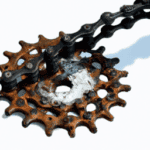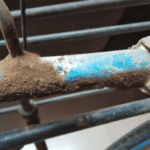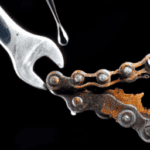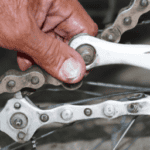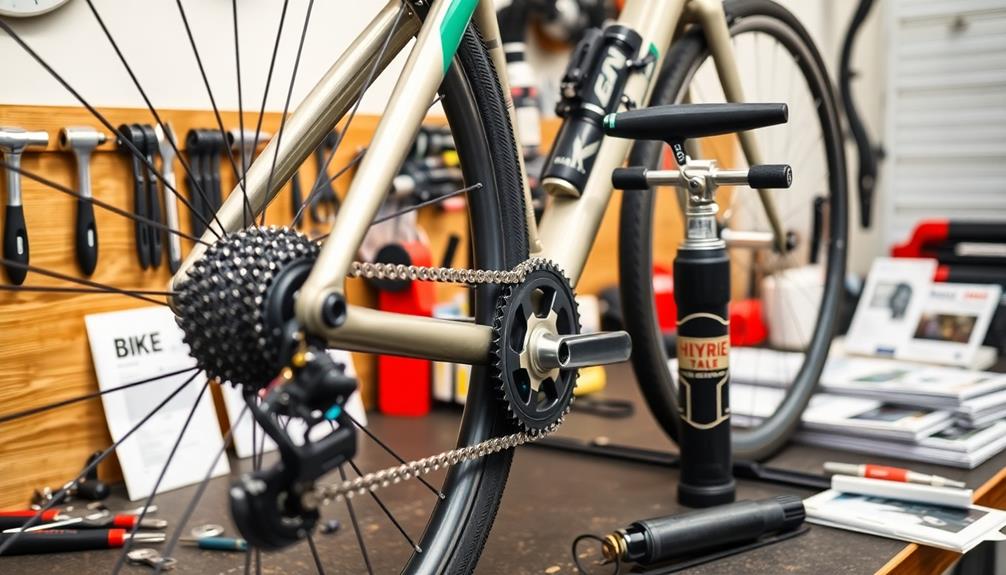Hello! I specialize in removing rust from bike chains, and I’m here to assist you in eliminating all that corroded debris from your chain. Fear not – it’s easier than it appears! Equipped with the appropriate tools and a little effort, your chain will be gleaming anew before you know it.
I know from experience that rust can seem daunting at first, but don’t let it discourage you. It’s actually pretty easy to remove – all you need is a few simple items and some patience.
In this article, I’ll walk you through the steps for removing rust from your bike chain so that you can keep pedaling without any problems.
Ready to get started? Let’s go!
Causes Of Rust On Bicycle Chains
Rust can be a major problem for bicycle chains. It’s important to know that rust can form on the surface of a bike chain, and if left unchecked, it can cause serious damage. In order to prevent rust from forming and to keep your bike chain in great condition, it’s important to take preventive measures.
When it comes to removing rust from bicycle chains, there are several methods that can be used to do so safely and effectively. From using steel wool or wire brushes to chemical solutions like vinegar or WD-40, there are several ways to get rid of rust without damaging your bike chain any further. It’s important to choose the method that works best for you and your bike chain.

No matter which method you decide to use, it’s essential to make sure that any remaining dirt or debris is removed before moving onto preventing future rusting issues. If this step is skipped then the effectiveness of any preventive measures taken will be greatly diminished.
To start off on the right foot with prevention strategies, all dirt and debris must first be removed from the surface of the bike chain.
Prevention Strategies
Rust is an unavoidable part of the bike-riding experience, but there are steps you can take to minimize its effects and keep your bike chain looking healthy. As a rust removal expert, I’m here to tell you that with proper care of your bike, you can avoid the potential of rust forming in the first place.
To prevent rust from forming on your bike chain, I recommend taking three simple steps:
- Keep your bike clean. This won’t just make it look better – dirt and mud left on the chain are a prime environment for rust to form.
- Store it properly when not in use. If you’re storing your bike outside or in a humid environment, make sure to wipe down all exposed metal parts before covering them with a protective cloth or keeping them indoors.
- Lubricate the chain periodically. This will help minimize wear and tear while also providing a barrier against moisture.
Taking these few simple steps will help ensure your bike stays rust-free and ready for adventure!
Simple Rust Removal Techniques
Removing rust from bike chains can be tricky, but with the right tools and some elbow grease, you can easily get rid of the pesky corrosion.
First, you’ll need a rust remover. Many formulas are available on the market, so choose one that works for your type of chain.

Next, make sure to remove the chain from your bike before applying the remover – this will help you get into all those hard-to-reach spots.
After liberally coating the chain in rust remover, let it sit for 30 minutes or more depending on how much rust is present.
Then rinse off the rust remover and scrub away any remaining residue with a brush or cloth.
Once you’ve removed as much rust as possible, it’s time to start lubricating your bike chain again.
Begin by using a degreaser to clean off any gunk or dirt that may have built up during removal.
When cleaning your chain, it’s important to do so carefully and not overwork it too much – otherwise you risk breaking it completely!
Finally, apply a fresh layer of lubricant to ensure that your bike chain has proper protection against future corrosion and wear.
This will help keep your bike running smoothly for many rides to come!
Using Wd-40 Effectively
Now that you know the basics of rust removal from bike chains, let’s take it a step further and discuss how to use WD-40 effectively.
WD-40 is an effective rust remover, as well as a lubricant, so it’s great for removing rust from bike chains.
To begin, make sure you have the right materials: a can of WD-40 and some cloths.
Start by spraying your rusty bike chain with the WD-40 until it’s completely covered.
Once it’s been sprayed down with WD-40, let it sit for a few minutes to allow the product to break down any rust particles and dissolve them away.
After a few minutes have passed, use a cloth to wipe down the chain and remove any debris or excess WD-40.
You may need to repeat this process several times before all of the rust is removed from your bike chain.
Once you’ve successfully removed all of the rust from your bike chain using WD-40, make sure you give it a good coat of chain lube to protect against future corrosion and oxidation.
This will help keep your bike chain in top condition for longer periods of time!
Now that we have discussed how to use WD-40 as an effective way to remove rust from bike chains, let’s move on to sourcing chemical rust removers that are specifically designed for this purpose.
Sourcing Chemical Rust Removers
If you need to remove rust from the bike chain, you may be looking for an effective chemical rust remover. As a bike chain rust removal expert, I know that not just any product will do – you need the right combination of solvents and abrasives to get the job done.
The first step is to make sure that your bike chain is clean and dry before applying the chemical rust remover. This will help it to penetrate deeper into the metal and get rid of all the rust.
Once it’s applied, let it sit for a few minutes before scrubbing off the rust with a wire brush or an old toothbrush. Then rinse off with water and dry thoroughly to keep your bike rust-free.
It’s important to remember that chemical rust removers should only be used if other methods of removal are not successful. They can be very effective at removing stubborn rust, but they also have their drawbacks as they can cause damage if not used properly.
The next step after using a chemical rust remover is to soak the bike chain with a degreaser to ensure all traces of the chemicals have been removed.
Soaking The Chain With A Degreaser
When it comes to removing rust from bike chains, soaking the chain with a degreaser is a key step. It’s important to make sure you use the right type of degreaser, as some chemicals can damage the metal of the chain links. I always recommend using a non-corrosive, biodegradable degreaser.
Once you have your degreaser ready, place your bike chain in a container and completely submerge it in the degreaser. Let it soak for at least 15 minutes – this gives time for the degreaser to break down and dissolve any rust on the chain.
After that, remove your chain from the container and give it a good rinse with water. This will help get rid of any remaining dirt or grease on your chain and prepare it for scrubbing.
Your bike chain should now be clean and free from dirt and grease – but not necessarily free from rust! If there are still signs of rust on your chain links, then you’ll need to move onto the next step: scrubbing your chain to remove any remaining rust.
Scrubbing The Chain To Remove Rust
Now that the bike chain is soaked and degreased, it’s time to start scrubbing away the rust. You can use a stiff brush or an old rag to get at the rust on the surface of the chain. This is the best way to remove rust from bike chains, as it allows you to get into every nook and cranny of the chain.
Here are five tips for getting all that rust off:
- Use a stiff brush with firm bristles
- Scrub in circles around each link
- Make sure to get both sides of each link
- Don’t forget about any crevices in between links
- Wipe off any excess dirt and grime with a rag after scrubbing
Once you feel like you’ve gotten all the rust off, give your chain one final wipe down with a rag. This will help ensure that no dirt or grime is left on your bike chain before you put it back together.
Now that your bike chain is free of rust, it’s time to focus on storing and maintaining your bike so that it stays in great condition for years to come!
Storing And Maintaining Your Bike
When it comes to bike maintenance, rust is one of the most relentless enemies of your bike chain. It’s a classic battle between man and machine – but with the right knowledge and supplies, you can get rid of rust before it takes over.
The first step in defeating rust is to properly store your bike. To make sure it runs smoothly, hang your bike up using a bike stand to make sure no water or dirt build up over time.
Then inspect your bike chain for any signs of rust or dirt buildup. If you spot any, take some classic chain lube and apply it directly to the affected area, then use a cloth to rub away the remaining residue.
This will help prevent further damage from occurring and keep your chain running smoothly. It won’t take long – just a few minutes here and there – but will go a long way in keeping your beloved bike running like new for many years to come.
With that being said, let’s move on to discuss the effects of rust on the bike chain.
Effects Of Rust On The Bike Chain
Rust is a common problem for bike chains and can be difficult to remove without the right tools or knowledge. It’s important to keep a rusty chain clean, as it can cause wear and tear on all of the other components in your bike.
If you’ve noticed rust on your bike, there are a few different ways to remove rust from your bike chain. The quickest and easiest way to remove rust from your bike chain is by using an old toothbrush and some WD-40.
Start by spraying the chain with WD-40, then use the toothbrush to scrub away at any visible rust. Once you’ve cleaned off all of the rust, rinse off the chain with water and dry it off with a cloth.
If this method doesn’t work, you may need to look into professional rust removal services for help cleaning a rusty bike chain. A professional can provide you with more powerful tools like wire brushes or chemical solutions that will get rid of any remaining rust on your chain quickly and effectively.
Moving forward, it’s important to take steps towards preventing further rust damage so that you can maintain the longevity of your bike’s parts. When it comes time for professional rust removal services, make sure you do your research and find a reputable service provider who knows what they’re doing. That way, you can ensure that your bike is running smoothly now and in the future!
Professional Rust Removal Services
When it comes to removing rust from bike chains, there are a few options available. The most common is to take your bike chain to a local bike shop for professional rust removal services. This can be a great option if you have an excessive amount of rust on your chain, as it can remove the rust quickly and easily.
If you decide to do this yourself at home, then you will need some specialized tools and equipment. You will need items such as wire brushes and lubricants designed specifically for bike chains in order to get rid of the rust. It may also be necessary to purchase a new chain if the current one is too far gone.
Overall, it’s important that you take good care of your bike chain in order to keep it looking its best and running smoothly. Taking it into a professional for rust removal services or purchasing the right tools and supplies can help ensure that your bike remains in top condition for many years to come.
Frequently Asked Questions
What Is The Best Way To Protect A Bike Chain From Rust?
As the old adage goes, ‘an ounce of prevention is worth a pound of cure’, and this couldn’t be more true when it comes to protecting your bike chain from rust.
As an expert in rust removal, I can tell you that the best way to protect your bike chain from rust is to regularly clean and lubricate it. This will help keep dirt and moisture away from the chain, both of which are the main causes of rust.
Additionally, storing your bike somewhere dry will also help prevent rusting, as well as using a protective coating on the chain itself.
How Long Should A Bike Chain Be Soaked In A Degreaser?
Soaking a bike chain in a degreaser is an effective way to remove rust and other debris.
Generally, I recommend soaking the chain for at least 15 minutes.
You may need to extend the time depending on the severity of the rust, but it shouldn’t exceed 30 minutes.
Make sure you use gloves and protective eyewear when dealing with harsh chemicals, as degreasers can be harmful if not handled properly.
What Are The Long-Term Effects Of Rust On A Bike Chain?
Rust is a serious issue when it comes to bike chains, as it can significantly reduce the life of your chain. In fact, the long-term effects of rust on a bike chain are so severe that it can cause irreparable damage and weaken the links, ultimately leading to breakage.
As a bike chain rust removal expert, I would advise everyone to regularly inspect their bikes for signs of rust and take immediate action if any is found. This is the best way to ensure that your bike’s drivetrain remains in good condition for years to come.
Is Wd-40 An Effective Rust Remover?
Yes, WD-40 is an effective rust remover.
In fact, it’s one of the most popular products for removing rust from bike chains.
It penetrates the rust and loosens it up so you can easily scrape it away.
WD-40 also leaves a protective coating behind that prevents further corrosion, so your chain will be protected from future rusting.
Can A Bike Chain Be Professionally Rust-Proofed?
The answer to whether a bike chain can be professionally rust-proofed is yes. It’s a great way to ensure your bike chain stays rust-free for as long as possible.
Rust can easily accumulate on bicycle chains due to exposure to moisture and other elements, but with professional rust-proofing, you can protect your bike chain from corrosion and other damage.
Professional rust-proofing services use special products and processes that are designed specifically to protect bike chains from the elements. The process usually involves applying a protective coating or sealant onto the bike chain, which helps prevent it from corroding or becoming brittle over time.
Conclusion
As a bike chain rust removal expert, I can confidently say that there is no one-size-fits-all answer when it comes to removing rust from bike chains.
Depending on the severity of the rust, the best approach could be anything from a simple degreasing and lubricating to a full professional rust-proofing job. It all depends on how much time and effort you are willing to put into it.
If you are looking for long-term protection against rust, then I recommend investing in a professional rust-proofing service. This will ensure that your bike chain is properly taken care of and protected against any future corrosion.
Remember, taking preventive measures now can save you a lot of headaches down the line!
WD-40
If you want to clean rust on your bike chain, WD-40 can be an excellent tool to use. It can be applied to the chain with a cloth or even in a washing machine. This product can help you clean the rust from your bike chain and extend its lifespan. It can also reduce wear and tear on the chain.
The first step to cleaning rust on your bike chain is to inspect your bike chain. Generally, rust doesn’t affect the whole chain, but only a portion of it. If you don’t see any rust, try hanging the chain upside down or hanging it against a wall to check for rust. When you start cleaning rust, make sure you use a stable surface to avoid damaging the chain.
When cleaning rust from your bike chain, you need to remove the master link, which is different from the other chains. You can then take apart the rest of the chain. After removing the chain, make sure to wiggle it a few times to remove dirt buildup. Now, you can use a scouring pad and a degreaser. Once the scouring pad is wet, you should wipe the area with force.
WD-40 can be a great solution for cleaning rust from your bike chain, but it is important to remember that WD-40 is a solvent and can cause damage to your bike if applied improperly. Make sure that you apply WD-40 to all rusted parts and leave it on for at least 10 minutes. If you have a severe case of rust, you may need to replace the entire chain.
Another way to clean your bike chain is to use olive oil. This oil can help prevent corrosion and rust, and it can also protect it from dirt and filth. However, olive oil only has a short-term effect and should only be used as a last resort.
WD-40 is the most popular way to clean a bike chain. The product is available in a spray form and has numerous uses. It is a great degreaser and cleaner, as well as a light lubricant. However, WD-40 should not be applied to bike brake pedals if you do not have any lubricant for your pedals.
After cleaning the bike chain, you should lubricate it. This will help the WD-40 remove stubborn rust and allow the chain to be reattached to your bike. The lubricant will also keep the chain from rusting. If you have a severe case of rust on your bike chain, you may want to consider replacing it altogether.
If you are looking for a simple way to clean your bike chain and derailleur, you can use WD-40 to remove rust. The lubricant works by loosening grime and oil grease that can clog the bike chain. Then, use a cleaning sponge and soap and water to scrub the chain.
Cleaning with Nylon Brush
Cleaning rust from bike chains is an important aspect of bike maintenance. Since bike chains are made of iron, they react with moisture and air to form rust. It’s important to clean your bike chain after every ride, especially if you live in a humid area. This will prevent further rusting.
Before cleaning your bike chain, you should remove the bike and inspect the chain thoroughly. If you notice a large amount of rust, it’s best to replace the chain. However, if the rust has spread throughout the chain, you can try cleaning it with lime juice or WD-40. After cleaning the chain, lubricate it and reattach it to the bike.
If you can’t get rid of all the rust with a nylon brush, try soaking the chain in degreaser. However, be careful because this process can be a bit rough on your hands. Another alternative is to soak a steel wool piece in lime juice and scrub it on the rusty parts. The degreaser will break down the particles that make up the rust. Once you’ve soaked the chain, you can wipe it off with a paper towel or dry cloth.
Another option is to use steel wool that has been dampened with lime juice or citric acid. While doing this, be sure to wear gloves. Then, you can use a steel brush to clean the parts that can’t be reached with a nylon brush. You can also use an old toothbrush to scrub the parts of the bike chain that are especially rusty.
After cleaning the chain, you can apply rust converter to protect the metal and prevent it from forming rust again. After cleaning, you can lubricate the chain and put it back on the bike. You can also apply wax or clear varnish to the bike to keep it from rusting.
The rust on bike chains is caused by moisture and a humid climate. However, it does not mean that the bike is broken. The rust is only damaging the metal. Therefore, cleaning rust from bike chains is not a difficult task. If you follow the tips outlined below, you should have no problem keeping your bike chain free of rust.
If you cannot find the master link, you can remove the chain manually. You can also jump the link of a gear spike. Plastic gloves can be very helpful in this process. Lastly, you’ll need a spray bottle. This bottle contains a solution of Coca-cola or vinegar. The amount of vinegar that you need depends on the size of the bike. This solution can be applied to the entire chain and is safe for people of all ages.
WD-40 or baking soda can be used as a lubricant on the surface of a bike chain. However, it’s not a permanent solution. WD-40 evaporates too quickly, which leaves little protection for the chain. In addition, rust can spread to other parts of your bike, so you should check your cycle regularly.
Muc-Off
If your bike chain has rusted, Muc-Off can help. The product comes in a trigger sprayer that can remove rust and oxidation. It works by reintroducing oxygen to metals that have been exposed to water and oxygen. It can be applied by brushing or spraying on the rusted area. Once you are done, rinse and dry the chain.
Muc-Off comes in neon yellow and is a biodegradable degreaser. The product is easy to use, just spray on the dirty part and rinse off. It comes with a spray bottle head that is designed to reach parts on all sides. This helps you clean even the toughest rust and grime. You can also use a brush to work the product into any small crevices. Muc-Off works well on metal, plastic, rubber, and seals, and is completely safe to use.
If you’re still having trouble with the rust, you can try applying lime juice to the chain. It contains citric acid, which helps break apart rust particles. You can also rub steel wool on the chain to remove light rust. It’s important to wear protective gloves and protect your eyes.
Another method to remove rust from a bike chain is to dampen steel wool with lime juice or citric acid. This will remove any remaining sticky residue and will also clean the chain. You should wash the chain thoroughly with soap and water afterwards. If the rust is stubborn, you can also use WD-40 spray. WD-40 is a powerful degreaser, but it’s not a lubricant.
If you’re unsure of how your bike chain works, the best way to clean a chain is to remove the masterlink first. It’s important to remove the masterlink first if the chain is heavy with surface rust. If the chain is only lightly rusted, however, it’s possible to clean the chain with the master link intact.
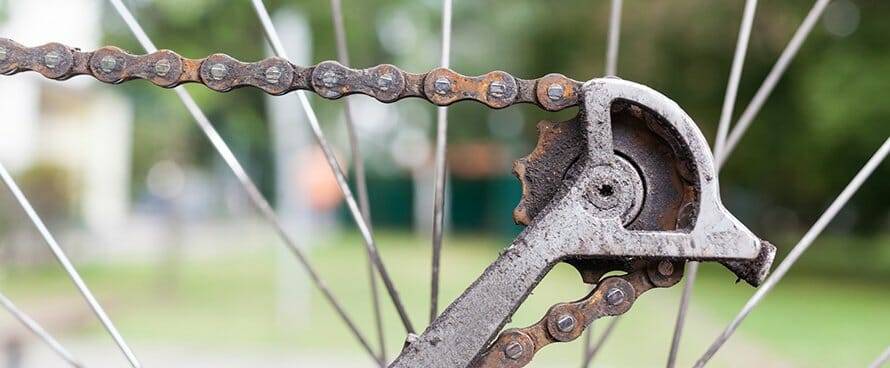

![WD-40 - 490224 Multi-Use Product with SMART STRAW SPRAYS 2 WAYS, 14.4 OZ [2-Pack] WD-40 - 490224 Multi-Use Product with SMART STRAW SPRAYS 2 WAYS, 14.4 OZ [2-Pack]](https://flatironbike.com/wp-content/uploads/2025/12/51zKbE6lzrL._SL500.jpg)
